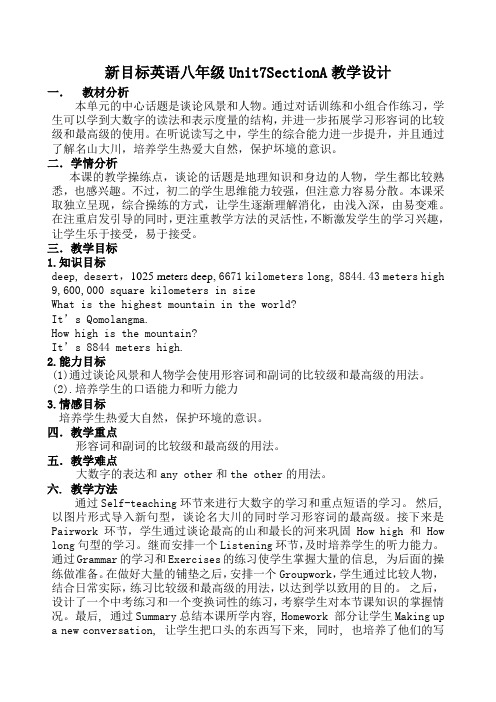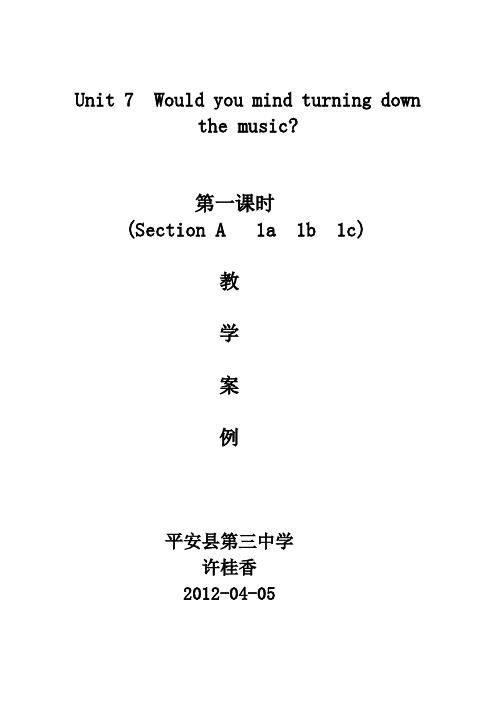8下第七单元学案(1-4课时)
- 格式:doc
- 大小:67.50 KB
- 文档页数:4


八年级下册英语第七单元教案3篇八班级下册英语第七单元教案篇2教学目标一、学问与技能1.学习并把握现在完成时的用法,学习有关音乐的词汇。
2.阅读短文获得正确信息的能力。
3.能够通过彼此交流了解歌曲、歌手、乐队的信息并能作评论。
能够运用阅读策略来获得文章大意。
4. 把握现在完成时的用法,学习有关音乐的词汇。
5. 培养学生的听力能力。
二、过程与方法阅读,感受,仿照,实践。
三、情感态度与价值观激发学生对音乐的喜爱。
教学重点1.学习并把握现在完成时的用法,学习有关音乐的词汇。
2.阅读短文获得正确信息的能力。
教学难点能够运用阅读策略来获得文章大意,从而提高阅读效率。
教法导航激励学生专心阅读,专心思考。
学法导航通过阅读,仿照学习新学问。
教学预备图片,多媒体。
教学过程Step 1 GreetingsGreet the students as usual.Step 2 Warming upShow some pictures about singers and musicians. Ask and answer:Who is your favorite singer or musician? Why do you like him or her?Step 3 New wordsLearn the new words:pop,rock,band.The students read the words one by one. Then they have a dictation.Step 4 ListeningThe students go through the sentences in 1b.1b, Listen to a conversation between Alex and Dave. Write A for Alex and D for Dave next to each opinion.____ The Toms must be popular.____ The Toms play pop music.____ The Toms’ music sounds more like rock.____ Listening to The Toms is a good way to wake up.1c, Listen again. Take notes.Listen for a third time and check the answers.Step 5 Speaking1d, Ask your friends and parents what kind of music they listen to and why. How does the music make them feel?Ask the students to make a conversation like:A:What kind of music do you listen to?B:I listen to pop music.A:Why do you listen to it?B:I like it because….A:How does the music make them feel?B:It makes me relaxed.Step 6 Discussion Reading2a, Discuss the questions with a partner.1.Do you have a favorite singer or band?2. Do you have a favorite song?3. What facts do you know about your favorite singer,band or song?Reading guidance:1. Read the passage and make notes or underline the mainidea of the text.2. After reading,write a short summary in your own words.在讨论的过程中,教授新单词。

新目标英语八年级Unit7SectionA教学设计一.教材分析本单元的中心话题是谈论风景和人物。
通过对话训练和小组合作练习,学生可以学到大数字的读法和表示度量的结构,并进一步拓展学习形容词的比较级和最高级的使用。
在听说读写之中,学生的综合能力进一步提升,并且通过了解名山大川,培养学生热爱大自然,保护坏境的意识。
二.学情分析本课的教学操练点,谈论的话题是地理知识和身边的人物,学生都比较熟悉,也感兴趣。
不过,初二的学生思维能力较强,但注意力容易分散。
本课采取独立呈现,综合操练的方式,让学生逐渐理解消化,由浅入深,由易变难。
在注重启发引导的同时,更注重教学方法的灵活性,不断激发学生的学习兴趣,让学生乐于接受,易于接受。
三.教学目标1.知识目标deep, desert,1025 meters deep,6671 kilometers long, 8844.43 meters high 9,600,000 square kilometers in sizeWhat is the highest mountain in the world?It’s Qomolangma.How high is the mountain?It’s 8844 meters high.2.能力目标(1)通过谈论风景和人物学会使用形容词和副词的比较级和最高级的用法。
(2).培养学生的口语能力和听力能力3.情感目标培养学生热爱大自然,保护环境的意识。
四.教学重点形容词和副词的比较级和最高级的用法。
五.教学难点大数字的表达和any other和the other的用法。
六. 教学方法通过Self-teaching环节来进行大数字的学习和重点短语的学习。
然后, 以图片形式导入新句型,谈论名大川的同时学习形容词的最高级。
接下来是Pairwork 环节,学生通过谈论最高的山和最长的河来巩固How high 和How long句型的学习。
继而安排一个Listening环节,及时培养学生的听力能力。

八下第七单元阅读教学设计标题:八下第七单元阅读教学设计正文:教学目标:通过本节课的阅读教学,学生将能够提高阅读理解能力,培养阅读兴趣,学会运用阅读策略,提升语言表达能力。
教学内容:本节课的教学内容为两篇文章:《探秘动物行为》和《动物的沟通方式》。
教学过程:开篇导入:引发学生对动物行为和沟通方式的兴趣教师可以通过展示一些图片或视频片段来引起学生对动物行为和沟通方式的兴趣,激发他们的思考和猜测。
教师可以提出一些问题,例如:“你们观察到过哪些动物的行为?”、“动物是如何进行沟通的?”等等,鼓励学生积极参与思考和讨论。
阅读训练:理解和掌握文章的主要内容和细节1. 第一篇文章:《探秘动物行为》教师将第一篇文章《探秘动物行为》呈现给学生,并指导学生阅读文章。
然后,教师提出一些问题,要求学生回答,例如:“这篇文章主要介绍了哪些动物的行为?”、“动物的行为是受什么因素影响的?”等等。
通过这些问题,促使学生理解文章的主要内容和细节。
2. 第二篇文章:《动物的沟通方式》教师将第二篇文章《动物的沟通方式》呈现给学生,并指导学生阅读文章。
然后,教师提出一些问题,要求学生回答,例如:“动物的沟通方式有哪些种类?”、“动物通过什么方式进行沟通?”等等。
通过这些问题,促使学生理解文章的主要内容和细节。
阅读策略训练:培养学生的阅读策略和学习方法教师在文章阅读过程中,引导学生掌握一些阅读策略和学习方法,例如:扫读、略读、推敲词义等。
教师可以通过阅读训练的过程中,提醒学生注意关键词,理解上下文语境,培养学生独立思考解决问题的能力。
语言表达训练:提升学生的语言表达能力在阅读完成后,教师将学生分成小组,鼓励学生互相交流和分享自己的理解。
每个小组选择一篇文章进行整理,并组织成简短的口头发言或小组展示。
通过这样的活动,学生不仅能够提升语言表达能力,还能够加深对文章内容的理解和记忆。
课堂总结:概括与反思教师进行课堂总结,概括本节课的重点内容,并与学生进行交流,让学生对本节课的学习进行反思和总结。

Unit 7 Would you mind turning downthe music?第一课时(Section A 1a 1b 1c)教学案例平安县第三中学许桂香2012-04-05Unit 7 Would you mind turning downthe music?第一课时教案(Section A 1a 1b 1c)(40分钟)一、本课时整体设计理念及思路:该单元是八年级下册的第七单元,主题是如何更礼貌的提建议,主要功能项目是提建议的学习以及如何作出合适的回答。
<<英语课程标准>>明确提出: 本课程倡导任务型的教学模式,要求教师应该避免单纯传授语言知识的传统教法,尽量使用任务型的教学途径.在这一理念的指引下,我确定本课教学的任务是让学生主动地学习和运用语言,使他们产生强烈的学习动机,从而使其成为自主的学习者.复习前面学过的表达礼貌的请求方式,然后过渡到本课时新的内容。
就从他们的日常生活谈起,询问他们周末在家干什么,这样不会很唐突。
接着围绕着这一主题安排了听、说、读、写的活动任务让学生在这些环节中学会用更加礼貌的请求方式“W ould you mind doing things ?”“W ould you mind not doing things?” 以及表示歉意的回答—Sorry ,Not at all / I’ll do it right away 等,最后的作业落实到学生的日常生活当中,把知识运用到实际生活中,达到学以致用的目的。
二、学情分析及教学策略本课话题来自学生的生活经历,在八年级上册Unit 11学生已经学习了许多动词短语,为表达提供了语言基础。
此外,学生已掌握了用祈使句和Can you…?/could you 及Could you please提出请求, 为本课的学习打下了铺垫。
具有了学习本单元知识的认知前提,能自然的与本单元的话题衔接。
但是,在语法上也就容易形成混淆。

第三节两栖动物的生殖和发育学习目标:1、知识目标:描述两栖动物的生殖和发育过程及特点。
2、过程与方法:培养学生收集、分析、处理信息的能力。
3、情感、态度、价值观:通过实践活动和资料分析,关注两栖动物的生殖发育与环境的关系,增强学生的环保意识学习重点:描述两栖动物的生殖和发育过程及特点。
学习难点:实践活动和资料分析,关注两栖动物的生殖发育与环境的关系学习准备:1、有关青蛙生殖与发育的图片2、有关两栖动物与环境的关系一、预习导学:学习任务一:了解青蛙的生殖过程1.“黄梅时节家家雨,青草池塘处处蛙”,说明青蛙的繁殖季节是。
2.青蛙繁殖季节,常见的生殖现象有、等。
3.青蛙的卵和精子在中完成受精形成,是受精。
4、雄蛙和雌蛙经过_______,分别把精子和卵细胞排到_______中,精子和卵细胞在_______中结合,形成受精卵,这种受精方式叫______________。
(二)两栖动物的发育1、青蛙的发育过程经过了__________、__________、_________、_________四个时期,这种发育方式叫__________ 。
2、青蛙的生殖和发育都离不开__________,湖泊、河流的干涸及水体的污染都会造成青蛙数量的下降,因此我们要保护好它们的生活环境。
3、除青蛙外,__________、__________等也属于两栖动物,它们的生殖和发育的共同特征是__________、__________。
二、学习任务二:掌握两栖动物的生殖和发育的特点合作探究(组内成员相互交流学习,讨论后达成共识)1、雄蛙鸣叫的意义是什么?2、雌雄蛙抱对对生殖有什么意义?3、蛙卵有什么特点?蛙卵的这种特点有什么意义?4、青蛙个体发育的起点是什么?哪一个时期特别像鱼?三、展示提升1、请同学们从外部形态、运动器官、生活环境、呼吸器官等方面比较青蛙和蝌蚪。
2、青蛙的发育过程为什么属于变态发育?四、自学反馈检测(一)选择题1、青蛙被称为两栖动物的原因是( )。
初中语文新课程标准教材语文教课方案( 2019—2020学年度第二学期)学校:年级:任课教师:语文教课方案 /初中语文/八年级语文教课方案编订: XX文讯教育机构八年级下语文第七单元复习教课方案教材简介 : 本教材主要用途为经过学习语文的内容,培育学生的阅读能力、沟通能力,学习语文是为了更好的学习和工作,为了知足人类发展和实现自我价值的需要,本教课设计资料合用于初中八年级语文科目 , 学习后学生能获得全面的发展和提升。
本内容是依据教材的内容进行的编写,能够放心改正调整或直接进行教课使用。
名言名句1.《长歌行》叹息光阴飞逝、生命短暂,尔后又由情入理,鼓励人们奋斗努力、有所作为的人生真理的是(《长歌行》中与“黑发不知好学早,白首方悔念书迟”意思同样)2.《望洞庭湖赠张丞相》诗中写诗人登上岳阳楼所看到的风起云涌的画面的是:委宛的表达了自己想当官而没人举荐,不可以在天下天下升平出仕为官,为民谋利,深感愧疚的苦处的是:3.王维《山居秋暝》以动写静,以动衬静,以亮写暗,以亮衬暗,以有声写无声,以有声衬无声,奇妙地写出了山林的清静的是:写出了山间社会生活的清静的是:委宛地表达了诗人信心远离政界、洁身自爱、归隐山林的理想的是:4.《岳阳楼记》中写的滕子京谪守巴陵君一年所获得的绚烂政绩是:政通人和, 百废具兴。
写岳阳楼“大观”或概括洞庭湖全景的是:衔远山,吞长江,浩浩汤汤,横无际涯,朝晖夕阴,气象万千。
写洞庭湖漂亮夜景:尔后长烟一空,皓月千里,浮光跃金,静影沉壁,渔歌互答,此乐何极!抒发生者阔大胸怀的名句是:“不以物喜,不以己悲”表达作者政治志向的千古名句的是:“天生下之忧而忧,后天下之乐而乐”。
照顾开头,表达与滕子京志同道合的是:噫!微斯人,吾谁与归!5.欧阳修《醉翁停记》表现作者情味的名句:“别有用心不在酒”此刻作为成语,一般含贬意,比喻别有专心。
别有用心不在酒,在意山川之间也。
写山间朝暮之景:日出而林霏开,云归而岩穴暝。
初中英语八下第七单元教案一、教学目标:1. 知识目标:(1)能够熟练运用本单元核心单词和短语进行日常交流。
(2)能够理解并在适当的情境中运用本单元所学的语法知识。
(3)能够理解课文内容,掌握课文中的关键信息。
2. 能力目标:(1)能够提高听说读写的能力,尤其是听力和口语表达能力。
(2)能够通过阅读和听力,获取和处理信息。
3. 情感目标:(1)培养学生的团队协作精神,提高他们的交际能力。
(2)培养学生的跨文化交际意识,增强他们的文化素养。
二、教学重难点:1. 重点:本单元的核心单词、短语和句型。
2. 难点:本单元的语法知识和跨文化交际。
三、教学过程:1. 导入:(1)利用图片或实物引导学生回顾本单元的主题。
(2)通过提问,激发学生的学习兴趣,引导学生进入学习状态。
2. 课堂学习:(1)单词和短语的学习:通过例句和练习,让学生熟练掌握本单元的核心单词和短语。
(2)语法知识的学习:通过例句和练习,让学生理解和掌握本单元的语法知识。
(3)课文学习:通过阅读课文,让学生理解课文内容,掌握课文中的关键信息。
3. 课堂练习:(1)听力练习:通过听录音,让学生获取和处理信息,提高他们的听力能力。
(2)口语练习:通过角色扮演或小组讨论,让学生运用本单元的知识进行日常交流,提高他们的口语表达能力。
(3)阅读练习:通过阅读练习,让学生理解和运用本单元的知识,提高他们的阅读能力。
4. 课堂小结:(1)对本单元的知识进行总结,让学生巩固所学。
(2)布置作业,让学生课后巩固所学知识。
5. 课后作业:(1)抄写本单元的核心单词和短语。
(2)完成本单元的练习题。
(3)预习下一单元的内容。
四、教学反思:通过本节课的教学,学生是否掌握了本单元的核心单词和短语?是否理解并掌握了本单元的语法知识?学生的听说读写能力是否有所提高?这些都是我在课后需要反思的问题。
同时,我还需要关注学生的学习情况,针对不同学生的特点,调整教学方法,以提高教学效果。
人教版八年级英语下unit7教案Unit 7 Teenagers should be allowed to choose their own clothesTeaching Goals:1. To help students understand and use vocabulary related to clothing and fashion.2. To enable students to express their opinions on school uniforms and dress codes.3. To develop students' speaking and writing skills through discussions and written assignments.4. To encourage students to think critically about rules and regulations in schools.Teaching Procedures:Step 1: Warm-up (10 minutes)- Start the class by asking students about their opinions on school uniforms. Do they prefer wearing uniforms or casual clothes to school? Why?- Show pictures of different types of school uniforms and casual outfits, and ask students to describe each one.- Introduce key vocabulary related to clothing and fashion, such as "trendy", "stylish", "fashionable", "casual", "formal", etc.Step 2: Reading and Vocabulary (15 minutes)- Hand out the reading passage about school dress codes and uniforms to students.- Ask students to read the passage silently and underline any key vocabulary words they are unsure of.- Have students work in pairs to discuss the meaning of the vocabulary words and come up with synonyms or definitions for each word.- Go over the vocabulary words as a class and make sure students understand their meanings.Step 3: Discussion (20 minutes)- Divide the class into small groups and give each group a list of discussion questions related to school dress codes.- Encourage students to express their opinions and provide reasons to support their views.- After the group discussions, have a class debate on whether teenagers should be allowed to choose their own clothes in school.- Ask students to present their arguments and counterarguments in the debate.Step 4: Writing Assignment (20 minutes)- Assign a written assignment to students, asking them to write an essay on whether school uniforms are necessary or if teenagers should be allowed to choose their own clothes.- Provide a list of guidelines for the essay, such as using persuasive language, providing examples to support their arguments, and structuring their essay with an introduction, body, and conclusion.- Collect the essays at the end of the class for grading and feedback.Step 5: Follow-up Activity (10 minutes)- To wrap up the lesson, play a fashion show game where students can showcase their own style and creativity by dressing up in different outfits.- Encourage students to describe their outfits and explain why they chose to wear them.- Reward students with prizes for the most creative or stylish outfits.Homework:- For homework, ask students to research on dress codes in different schools around the world and write a short report on their findings.Evaluation:- Evaluate students based on their participation in class discussions, their written assignments, and their ability to express their opinions clearly and persuasively.Overall, this unit will help students develop their critical thinking skills, improve their vocabulary and language proficiency, and engage in meaningful discussions on a relevant topic that affects them directly - school dress codes and rules. By the end of the unit, students should be able to express their opinions confidently and respectfully, and understand the importance of individuality and self-expression in the context of school uniforms and clothing choices.。
Grade 8 Unit7 What’s the highest mountain in the world?第一课时Section A (1a-2d)[预案] A翻译1. 无需拘束做某事2. 据我所知3. 人口众多4. 人口少5. ……有多少人口6. 任何一座山7. 人造物体B 完成句子8. 什么山是世界上最高的山?9. 它比美国拥有更悠久的多的历史。
10.中国几乎跟美国一样大。
11. 这道城墙有多大?12. 八达岭是明长城的一部分吗?[学案] Step 1. Lead in.Step2. A listening practice “1b”Step3. Listen and number the facts(1-4)“2a.2b”Step4. Role-play the conversation.一、单项选择:()1. is the bridge? It’s about 2000 meters.A. How far.B. How much.C. How long.D. How wide. ()2.Which city has population, Beijing, Wuhan or Shiyan?A. the largest.B. the smallest.C. the mostD. the least. ()3. I know Tom is good at English.A. as far as.B. as well as.C. as soon as( ) 4. Sam is than any other player in the school team.A. tall.B. taller.C. tallest.D. more tall.二、词汇。
1. There are five (正方形) in the picture.2. London is full of (游客) in summer.3. She is studying a history.4. Qomolangma is the (high) mountain in the world.5. She said,“we have to p these animals”.三、句型转换。
1. How large is the population of your hometown? (同义句)your hometown?2. Mary is the tallest girl in our class. (同义句)Mary is girl in our class.3. 她戴着太阳镜以保护眼睛不受阳光的伤害。
She’s wearing sunglasses her eyes the sun.4. 现在尽管自由地表达你们自己的观点吧。
Now to share your own ideas!5. 据我所知,他将外出三个月。
he’ll be away for 3 mouths.Grade 8 Unit7 What’s the highest mountain in the world?第二课时Section A (3a-4c)[预案] A翻译1. 吸入,吞入(体内)2. 挑战自己3. 面对(问题,困难等)4. 自然力量5. 贯穿6. 即使,7. 冒生命危险 8.放弃做某事B 完成句子9. 喜马拉雅山横贯中国的西南。
10.甚至更严重的困难包括冰冻的天气条件和暴风雪。
11.当你接近顶部的时候,吸入空气也是非常困难的。
12.人们想在面对困难的时候挑战自己。
13.这些爬山者的这种精神告诉我们不要放弃努力实现我们的梦想。
[学案] Step 1. Lead in.(Show the pictures of the Himnlayas and Qomolangme and learn the new words.)Step2. Read the article and finish. ①the main ideas. ②Complete the chart. ③Answer the questions.Step3. Do some exercises using comparisons“4a.4b.4c”一、单项选择。
()1.Vines run the sides of the road.A. alongB. upC. down. D .to.( ) 2. There are ten people in this office me.A. includesB. include.C. included.D. including. ( ) 3. Fish take Oxygen through their gills.A. upB. into.C. in.D. for( ) 4. The policeman showed great bravery danger.A. in the face.B. in the front of.C. in the face ofD. before.( ) 5. I can’t believe a little girl can read many books.A. so, soB. such, such.C. so,suchD. such, so二、词汇。
1. I couldn’t work in these (条件)any longer.2. Coal and oil are (nature) products.3. This is a (challenge) task.4. I think she is one of the (popular) movie stars in China.5. Let the (力量)be with you.三、句型转换。
1. He is successful in passing the exam。
(同义句)He passing the exam。
2. This book is not as interesting as that one。
(同义句)That book is this one。
3. 医生叫他戒烟。
The doctor told him to .4. 许多老师即使生病了,仍然继续工作。
Many teachers still go on working they are sick.Grade 8 Unit7 What’s the highest mountain in the world?第三课时Section B (1a-2d)[预案] A翻译1. 双腿站立2. 许多倍3. 出生时4. 活到5. 为某人准备某物6. 死于疾病7. 每两年 8.在现存的森林里9.大约 10.绊倒11.走路时撞着B 完成句子12.大象比这只熊猫重好多倍。
13.他们正在给熊猫宝宝准备牛奶作早餐。
14.它们兴奋地跑了过去,当中的一些甚至撞到它们的朋友摔倒了。
15.人类捕捉鲸是为了得到肉,脂肪和油。
[学案] Step 1. With the pictures of “Elephant and panda”Then try to make comparisons like……(1a.1b.)Step2. Reading: ①Scan the article to find out……(2b)②Scan it again and answer questions(2c)③Complete the sentences using words and phrases(2d).Step3. Do more reading.一、单项选择:()1. Our school is than yours.A. bigger twice.B. twice bigger.C. two bigger.( ) 2. He could n’t help jumping with when he heard the news.A. excitement.B. excitedC. excitingD. excite.( ) 3. My kids spend hours on the phone to their friends.A. chat.B. to chat.C. chating.D. chatting.( ) 4. I hope there will be more forests for animals .A. to liveB. to live on .C. live inD. to live in.( ) 5. Don’t worry! I’ll do what I can you when you are in trouble.A. to help.B. helpC. helping.D. helped.二、词汇。
1. My little brother w 20 kilos.2. They did a (调查) about the living conditions of the pandas.3. Jane is still (wake) until 12:00 o’clock last night.4. She didn’t go to work because of her (ill).5. The government has made rules on whale (保护)。
三、句型转换。
1. There are (不到)30 students in the classroom.2. 这块大石头的重量是那一块的三倍。
The big stone is as as that one.3.她跑过来打招呼,但我不知道她的名字。
She to say hello, but I don’t know her name.4. 他死于去年的一场交通事故。
He a traffic accident last year.Grade 8 Unit7 What’s the highest mountain in the world?第四课时Self Check一、单项选择:()1. We must play a part in our earth.A. promisingB. protectingC. appearingD. polluting ( ) 2. She looks than she does.A. the more older.B. very older.C. much older.D. more older. ( ) 3. His books are more than mine.A. many time.B. more time.C. some time.D. many times. ( ) 4. The Great Wall is more than .A. 6000 kilometers longB. 6000 kilometer longC. 6000-kilometers longD.6000 kilometer longer( ) 5. What bad weather! The radio says it will be even later on.A. badB. badlyC. worseD. worst.( ) 6. The population of Henan is than that of Hubei.A. less.B. more.C. largerD. small.( ) 7. Junko Tabei was the first woman the top of Qomolangma.A. to reach.B. to get.C. reach to.D. get to. ( ) 8. the population of the city? It’s about 3million.A. How much is.B. How many are.C. What are.D. What is. ( ) 9. My father spends much money on books, he’s not rich.A. but.B. because.C. even though. D .unless.( ) 10.There will be a big show tomorrow night, and two on the weekend.A. moreB. otherC. else C. another二、词汇。